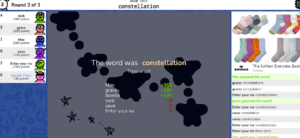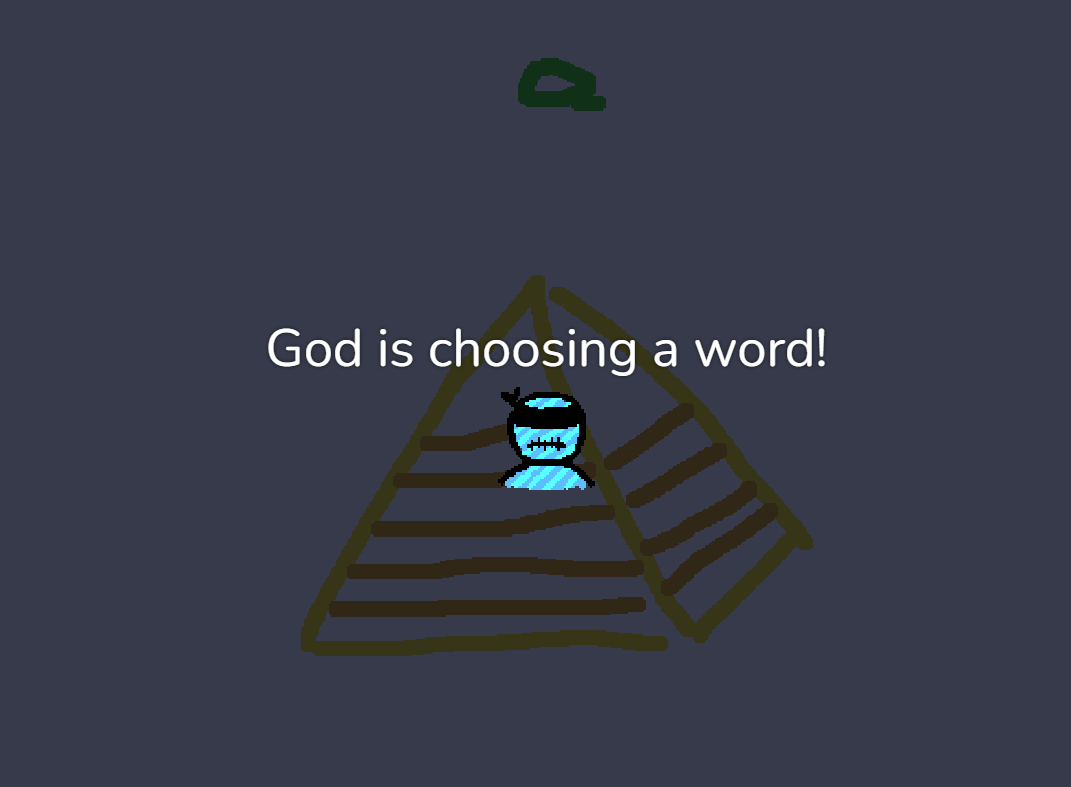For this week’s critical play, I played skribbl.io for the first time – a judging game that was very common among my friends during quarantine, but I never got into as I stayed loyal to Pictionary in-person with my family. (It’s our most well-loved family board game). Generally, Skribbl.io is meant for a wide audience, ranging from younger kids to adults who enjoy casually gaming for fun. The simplicity, interactive nature, and easy free accessibility via the web make it particularly popular among young adults and teenagers who have specific friend circles and might like to play games together, even when apart. The game was developed by ticedev, and you play it in web browsers, thereby accessible via PCs, tablets, and phones (though the UI gets a bit wonky with phones).
I played on my laptop with random people it selected for me. I hopped between several groups as sometimes I was kicked out for being idle or too many people left our game. Overall, in my experience playing skribbl.io, I found that the use of judging through guessing what artwork is supposed to represent affects group dynamics and relationships by creating competition yet also a communal environment through the chat window where everyone guesses. This duality enhanced engagement and social interaction but also led to competitive tension and strategy where players could take advantage of others.
In the game, the formal elements as relevant are rules as players must guess the word based on the drawing within a time limit, scoring points based on speed and accuracy, objectives as to accumulate the highest score by correctly guessing words or successfully communicating through drawings, and procedures as: each round, one player draws while others guess, cycling through all participants.
With the procedure of players judging the artist’s drawings to guess the word being depicted, it introduces a competitive element as players race to earn as many points as possible. This created a fun, high-energy competitive atmosphere but also caused frustration for me when I thought the drawing was super confusing but others in the chat got it quickly. Moreover, I noticed that users who couldn’t figure out how to correctly spell a word would spoil the answer in the chat for others, as only correct spellings are accepted and hidden from others. The users who knew what they meant to say would then immediately take advantage of this and use this as strategy with harder-to-spell words. Here is an example where I did this as I didn’t know it was supposed to be a Minecraft creeper.
Here is an example where I did this as I didn’t know it was supposed to be a Minecraft creeper.
![]() inappropriate username example
inappropriate username example
I often wished there was moderation, as sometimes, people would draw inappropriate shapes on the game board instead of actually trying to draw, or have inappropriate usernames. Unlike more structured drawing games like Pictionary, Skribbl.io’s open format allows for more spontaneity, which can be more engaging but less controlled, such as in the aforementioned scenario. The lack of these moderation tools (like Jackbox Games has) sometimes allows this behavior to disrupt the fun and flow, impacting the game’s social dynamics.
As an artist, it was gratifying when people guessed correctly, since this made you feel good about your drawing skills. You were also rewarded if people did guess correctly. This helped make the game fun and challenging for both roles as artist and guesser.
 here is me drawing the constellation word. It was very satisfying seeing people guess correctly.
here is me drawing the constellation word. It was very satisfying seeing people guess correctly.
Overall, analyzing through MDA, we see game mechanics involve drawing and guessing, with points awarded for speed and accuracy. These mechanics foster dynamics of competition (racing to guess words) and collaboration (inadvertently working together to understand drawings). As such, the primary aesthetic experiences include fellowship (through social interaction) and challenge (through competitive guessing, as well as drawing a random object well). Another significant mechanic is that of the chat. In Skribbl.io, the chat function allows players to input their guesses for what the current drawing represents. This is a fundamental action that players can take to interact with the game’s system and other players. The chat is not just for social interaction; it is integral to the gameplay as it is the primary method through which guesses are submitted and scored. Therefore, I will refer to it as a mechanic by being a rule-governed method for directly affecting outcomes in the game. The chat feature significantly influences the dynamics of the game as it enables real-time competition and inadvertent cooperation (more like communal guessing), influencing the pace and feel of each round as players react to each other’s guesses or just communicate for social interaction. The aesthetic experience is also affected as the chat can create a sense humor and camaraderie contributing to the social atmosphere that comprises much of the game’s appeal.



